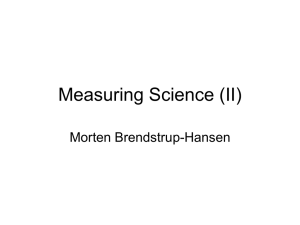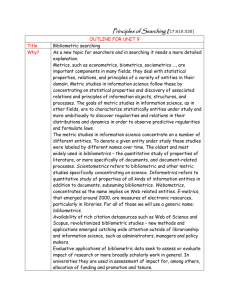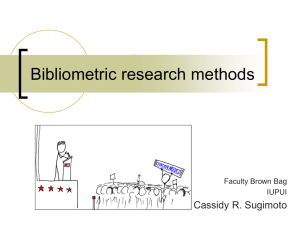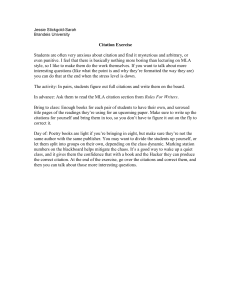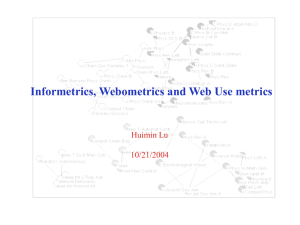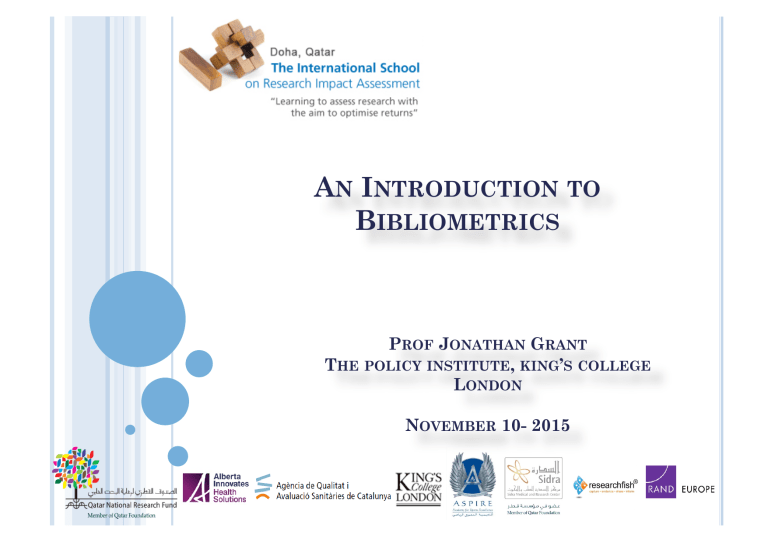
AN INTRODUCTION TO BIBLIOMETRICS PROF JONATHAN GRANT THE POLICY INSTITUTE, KING’S COLLEGE LONDON NOVEMBER 10- 2015 LEARNING OBJECTIVES AND KEY MESSAGES Introduce you to bibliometrics in a general manner Show you the basic requirements for conducting bibliometric analyses You will learn about invalid bibliometric measures around Build up expertise in bibliometrics before using it ! Use bibliometrics wisely, and in context ! CONTENT OF TALK Introduction of bibliometrics and data systems Basic requirements for bibliometric analysis Validity of research assessment Bibliometric indicators Some example uses THE METRICS TIDE PROVIDES GOOD OVERVIEW ON (BIBLIO)METRICS http:// www.hefce.ac.uk /media/ HEFCE,2014/ Content/Pubs/ Independentrese arch/2015/ The,Metric,Tide / 2015_metric_tid e.pdf WHAT IS BIBLIOMETRICS? • • The use of published scientific literature (articles, books, conference proceedings, etc.) for measuring research activity eg output volume, science 'quality', interdisciplinarity, networking New knowledge created by scientists is embedded in the scientific literature • By measuring scientific literature, we measure knowledge and the ways it is produced BIBLIOMETRICS RELIES ON INFORMATION IN A PAPER Journal Title Authors Addresses Abstract References BIBLIOGRAPHIC DATA SYSTEMS In the field we work with three bibliographic databases: Web of Science by Thomson Reuters; Scopus by Elsevier Science; Google Scholar by Google. Understanding strengths and weakness of different databases is key (i.e. “Coverage”) LEVELS OF BIBLIOMETRIC ANALYSIS Macro level eg country and region comparisons Meso level eg research organisation, universities, institutes Mirco level eg analysis of programmes, groups or individual researchers THREE METHODS OF DATA COLLECTION 1. Based on list of names of researchers 2. Based on a list of publications of a unit 3. Based on the address of a country or an institute ADDITIONAL ANALYSES CAN FOCUS ON .. Research profiles: a break down of the output over various fields of science. Scientific cooperation analysis: a break down of the output over various types of scientific collaboration. Knowledge user analysis: a break down of the ‘responding’ output into citing fields, countries or institutions. Highly cited paper analysis: which publications are among the most highly cited output (top 10%, 5%, 1%) of the global literature in that same field(s). Network analysis: how is the network of partners composed, based on scientific cooperation? ANALYSIS MAY GIVE AN INCORRECT IMPRESSION, IF DATA ARE NOT “NORMALIZED” Different fields have different citation patterns, expressed differently over time Constant This means it is important to normalise citation patterns by both field of research and year of publication This is done by comparing observed citations to expected citations for a field/year combination If bibliometrics data are not normalized, it could give the misimpression that certain fields or institutions are underperforming. THE IMPORTANCE OF NORMALIZATION: TWO PAPERS Year Title 2010 2010 Instructive role of the vascular niche in promoting tumour growth and tissue repair by angiocrine factors Journal NATURE REVIEWS CANCER (JIF=37.54) JOURNAL OF INVERSE Inverse spectral problems for AND ILL-POSED differential operators on PROBLEMS arbitrary compact graphs (JIF=0.43) Raw Citatio Cites/yr NCS ns WoS category 51 17.00 4.32 ONCOLOGY 5 1.67 4.81 MATHEMATICS The (mean) normalised citation score compares actual citations against expected citations by taking into account the field, age and document type of a paper. Also know as the: Relative citation score, average relative citation score, etc. WHICH MEANS THE H-INDEX AND JIF ARE POOR BIBLIOMETRICS INDICATORS! Journal Impact Factor (JIF) is the mean citation score of a journal, determined by dividing all citations in year T by all citable documents in years T-1 and T-2 Not (field or type) normalised Variance in citations of papers within a journal (so inflates the impact of all researchers publishing in a journal ) The h-index is based on the set of the scientist's most cited papers and the number of citations that they have received in other publications Not field normalised Is biased against youth and favours the old and the experienced SAN FRANCISCO DECLARATION ON RESEARCH ASSESSMENT (DORA) “Do not use journal-based metrics, such as Journal Impact Factors, as a surrogate measure of the quality of individual research articles, to assess an individual scientist’s contributions, or in hiring, promotion, or funding decisions” PREFERRED INDICATORS SHOULD BE NORMALISED Bibliometric indicators could best reflect actual impact of a unit under study. Therefore, compare actual versus expected impact. Take into account the field, age , and types of document you are dealing with. Stay away from “One-Indicator” thinking: preferably use a variety of indicators. SOME EXAMPLES OF BIBLIOMETRIC ANALYSIS: MENTAL HEALTH RESEARCH Volume of research publication in ‘mental health’ research SOME EXAMPLES OF BIBLIOMETRIC ANALYSIS GREECE R&D SYSTEM ‘Relative Citation Index’ (RCI) for all field and research institutions in Greece SOME EXAMPLES OF BIBLIOMETRIC ANALYSIS: SOCIAL CARE RESEARCH (1) Relationship between ‘Average Relative Citations’ and ‘Specialisation Index’ by country SOME EXAMPLES OF BIBLIOMETRIC ANALYSIS: SOCIAL CARE RESEARCH (2) Network analysis of relationships between UK universities FURTHER READING Wilsdon, J., et al. (2015). The Metric Tide: Report of the Independent Review of the Role of Metrics in Research Assessment and Management. DOI: 10.13140/RG.2.1.4929.1363 Campbell et al (2015). Comparative Performance of Adult Social Care Research, 1996– 2011: A Bibliometric Assessment. British Journal of Social Work, 1–19. doi:10.1093/bjsw/ bcv022. Lariviere et al (2013). International comparative performance of mental health research, 1980-2011. European Neuropyscopharmacology, 23, 1340–1347. Guthrie et al (2013) Measuring research: A guide to research evaluation frameworks and tools. Santa Monica, CA, RAND Corporation. Available: http://cssip.org/docs/meeting/ RAND_Full.pdf. Accessed 2015 May 23. Moed van HF (2005) Citation analysis in research evaluation. Springer, Dordrecht. Leeuwen T (2004) “Descriptive versus Evaluative bibliometrics. Monitoring and assessing of national R&D systems, pp. 373–388, in: Handbook of Quantitative Science and Technology Research, editors Moed H., Glanzel W., & Schmoch U, Kluwer Academic Publishers.
